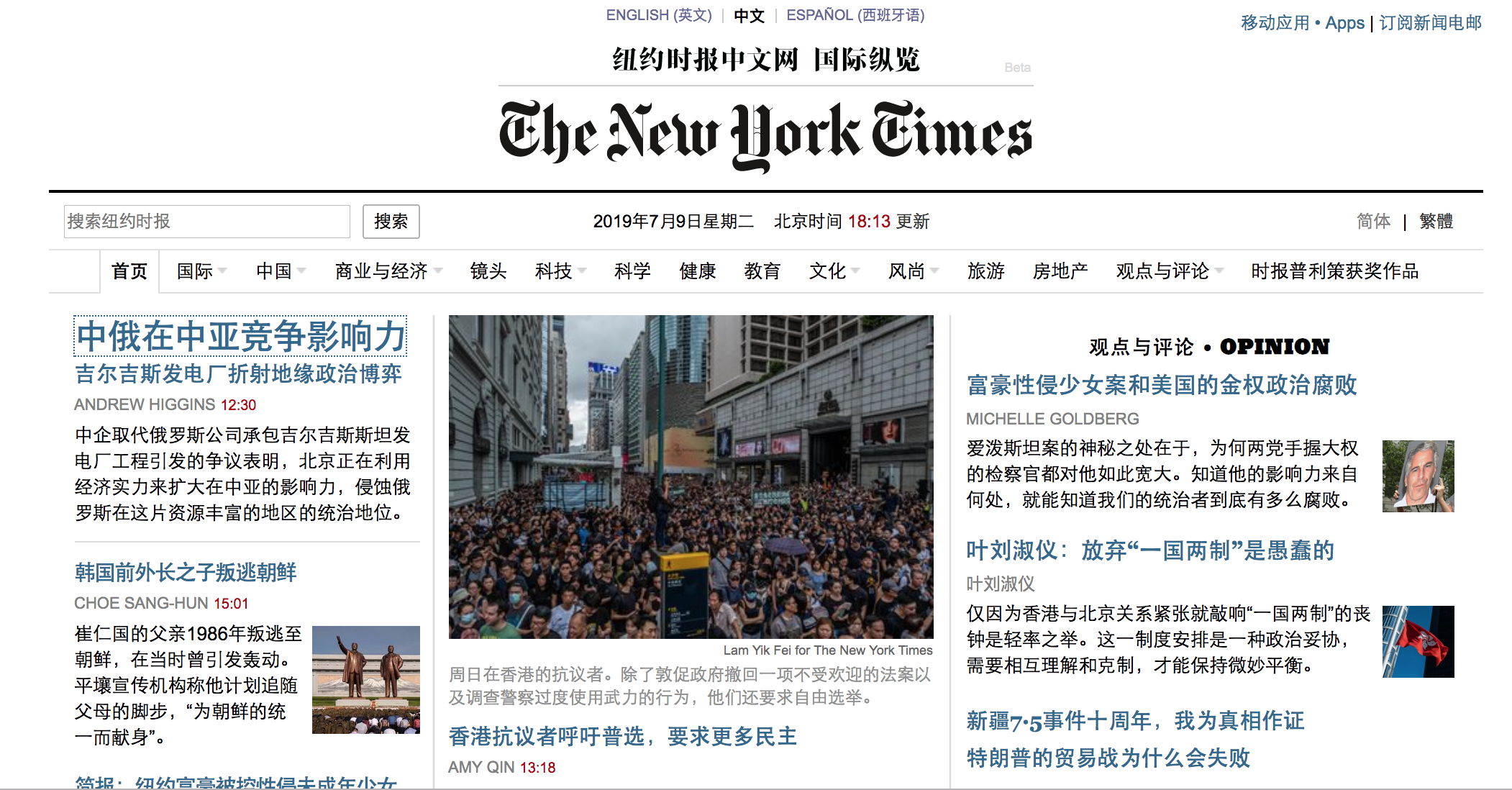
Amid Hong Kong protests, trade wars, and the 30th anniversary of the Tiananmen Square protests, it’s been a big summer for news about China — but of course it’s not easy for Chinese citizens to see uncensored versions of that news.
The news is there, however, for people who can use VPNs to get around the Great Firewall — and one place they can find it is at The New York Times’ Chinese-language edition, which turned seven this summer and was the paper’s first foreign-language edition. (The second was NYT en Español, which launched in 2016.)The site initially launched to attract China’s growing middle class. A few years in, it’s expanding, with an email newsletter, a WeChat account for non-political stories, and side-by-side Chinese/English versions of stories. I spoke with Ching-Ching Ni, editor-in-chief of the Times’ Chinese site and a 2009 Nieman Fellow, about her day-to-day job and what the Times hopes to accomplish in China. Our conversation, edited slightly for length and clarity, is below.
I went back to China to teach journalism and train the next generation of Chinese journalists at Shantou University. And then I got to transition into this current job as editor of the New York Times Chinese edition. Now I get to help share the best New York Times journalism with the entire Chinese-language-speaking world, and that is something I consider high-impact and super-meaningful.
I also do a lot of outreach to get the word out about the fact that there is a Chinese-language edition of The New York Times. A lot of people don’t know that, and whether I’m in China or America, part of my job is to tell people about it, to get the Chinese-language-speaking world aware of this amazing free public service that we provide at The New York Times.
This is important because our audience is both inside and outside of China — so we’re talking about the entire Chinese-language speaking world, which right now is very much in demand of a reliable, high-quality media outlet that can provide uncensored news and information about the world, and especially about China. Because of the heavy censorship out of China, the entire Chinese-language media world is under attack, so whether you’re inside China or outside, your ability to speak freely is highly limited now. The New York Times Chinese edition fulfills a critical role in this new world. We see this very much as part of our mission as The New York Times to help our readers understand the world.
What that means is that when there’s big news, our audience goes out of their way to find us. That’s why our traffic is rising. In terms of using the VPN, it is no doubt a challenge and a barrier, but when the information is not available to them anywhere else, I think enough people value what we do and they go out of their way to find us.
The government is making it more and more difficult to use the VPN, and we’re glad that the VPN still works. The other thing, of course, is we’re trying to grow the overseas audience as well, because Chinese speakers around the world don’t need a VPN, but they don’t always know we exist, so we’re trying to improve our outreach.

We also have a foothold inside Chinese social media: We have one WeChat account where we share non-sensitive political stories that are still high-quality and relevant, and we’re quickly growing that audience as well. It’s a different kind of audience there: Our main audience comes to us for about political news about China and the world that they won’t see anywhere else, but on WeChat, we share other things, like lifestyle or educational stories, that are also very relevant to our readers and perhaps help to develop a different kind of audience.
 We started a unique original Chinese feature called Word of the Day, where we take a word from the news and explain to the Chinese audience what it means. Because we have limited resources, we don’t translate every single NYT story — we have to pick and choose — and often we don’t have time to translate a lot of American cultural stories, for example. So we use Word of the Day to explain, for example, when the Met Gala happened and the theme was “camp” — what does “camp” mean in Chinese? Even a lot of English speakers don’t know what camp means. So we explained that. We’ll explain things like “grit.” And a lot of things related to Trump — what is “temperament,” things like that.
We started a unique original Chinese feature called Word of the Day, where we take a word from the news and explain to the Chinese audience what it means. Because we have limited resources, we don’t translate every single NYT story — we have to pick and choose — and often we don’t have time to translate a lot of American cultural stories, for example. So we use Word of the Day to explain, for example, when the Met Gala happened and the theme was “camp” — what does “camp” mean in Chinese? Even a lot of English speakers don’t know what camp means. So we explained that. We’ll explain things like “grit.” And a lot of things related to Trump — what is “temperament,” things like that.
Also, one of the unique things we offer on the Chinese New York Times is that we not only have a Chinese version of the stories that we translate, we have a bilingual side-by-side feature that allows readers to see a story in both English and Chinese simultaneously side by side. It’s a great learning tool, and it’s very time-consuming for us, but we do it as a public service and a lot of people enjoy that.
